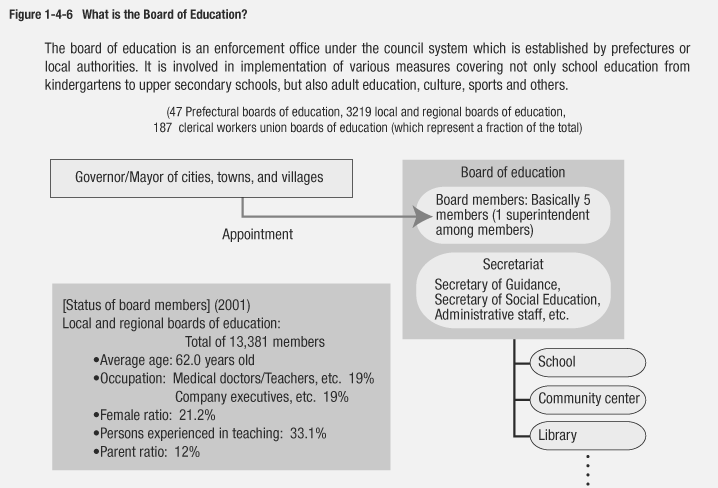| Home > Policy > White Paper, Notice, Announcement > White Paper > Japanese Government Policies in Education, Culture, Sports, Science and Technology 2002 >Chapter4 Section2.2 | ||
Educational reform requires various efforts from many bodies of society. Schools need to actively and willingly improve educational activities under the strong leadership of headmasters. Boards of education need to support these efforts by schools with specific measures, and at the same time, they are expected to carry out active and positive community-based education administration suited to the various ideas and demands of the local communities.
The Ministry of Education, Culture, Sports, Science and Technology has implemented many measures for the revitalization of boards of education based on the Second Report of the Extraordinary Educational Council issued in 1986. Projects carried out so far are the improvement of the management of boards of education, the selection process of board members, and the development of PR activities, etc.
The amendment of the law was made in 1999, and the appointment approval system of the superintendent of education was abolished under the omnibus bill for decentralization. Furthermore, the following measures are stipulated in last year's in order to reflect various opinions and ideas of local residents and parents or guardians. ("Law concerning Organization and Management of Local Education Administration) (Enforcement in January 2002):
Based on these amendments of the law, each local board of education is now expected to develop various measures reflecting ideas and opinions of the local communities in line with the conditions of the communities and schools.

Many active and unique promotions of educational activities are evident with the elaborate creation of reform plans and long -term projects.
The board of education also takes independent measures not only for schools but also for adult education, sports and cultural activities suited for each community. Some of the examples of measures for school education promoted by various boards of education are:
During the process of decentralization in the field of education, the real value of the board of education will be increasingly tested in order to carry out successful educational reform in each local community. In COLUMN 9 the example of Shinagawa ward is introduced. Each board of education is expected to work toward active and positive education administration considering ideas and opinions of parents and local residents.
|
The Board of Education of Shinagawa ward has implemented various measures as a part of the "Educational Reform Plan 21", and has provided financial support to each school. Examples of measures of educational reform plans
(1)Introduction of the school selection system to 58 publicly owned elementary and lower secondary schools in the ward
(2) Promotion of lessons according to student proficiency regardless of homerooms or grades (3) Promotion of the system in which different teachers present different subjects in elementary schools (4) Promotion of coordination between elementary schools and lower secondary schools (creation of 9-year integrated curriculum, lessons at elementary schools by the visiting teachers from lower secondary schools, coordinated school events, etc.) (5) Implementation of external evaluation conducted by parents or local residents (6) Implementation of an independently created survey on academic performance (on two subjects in both elementary schools and lower secondary schools) |
| Back To Top | MEXT HOME |